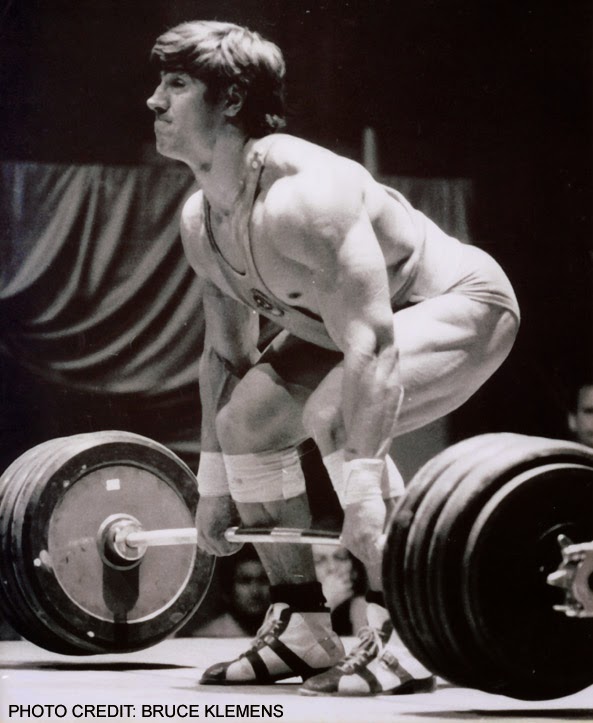
Broadening the Strength Training Template
One advantage to minimalistic absolute strength training, it leaves a lot of time for the other stuff
Every Sunday from 9 am to 11 am, we have our weekly strength training session. Ours is an organic group, sometimes expanding, sometimes contracting, a circle of likeminded hardcore strength athletes. We gather and classically, relentlessly, methodically, work through the “Core Four” progressive resistance exercises: squat, bench press, deadlift, and overhead barbell press.
At each lifting platform 4-5 men cluster and spot one another as each in turn steps up and does their warm-up sets leading to a top set. The others watch, exhort, and offer post-set technical critiques. Men lift better when lifting as other men watch.
Afterwards, those so inclined might hang out and engage in some bodybuilder-style pump ‘em up arm training. Or not. The crux, the irreducible essence of these workouts, is the ritualistic practice of the four lifts. Everyone has a lifting plan of attack, a schedule. Each week, every lifter has “periodized” targets in both poundage and number of reps, this in each of the four lifts. Everyone knows what is expected heading into every strength training session.
This past Sunday we had fourteen lifters working on three different platforms. Everyone adheres to our training template and tempo. At the end of the two-hour strength training session fourteen lifters had performed approximately 200 cumulative sets. Over the two-hour long session, not a single lifter missed a single rep on any set. Every man hit all their preplanned marks. No one missed a rep. This ‘no one misses a rep for an entire training session’ phenomenon is not an uncommon Sunday occurrence; it happens often and is no accident.
Successful periodization is rooted in ruthless initial self-assessment. The worst sin in periodization is to start a periodized cycle off too high, too heavy, too front-loaded. Successful periodization requires an egoless and realistic starting point. Lifts need be done strictly and with a full and complete ROM on every rep of every set. By adhering to this simplistic strategy of fewer things done better, over time, a man’s strength doubles. As an unintended side-consequence, those that religiously attend our Sunday morning power training sessions muscle up – big time.
Our strength training sessions occur in a picturesque setting, Don “Bubbles” Berry’s country gym. We have been going at it hammer and tongs for nearly a decade. All the regular attendees are rocked-out and muscled up. That is a given. Assuming you show up and participate, it would be a physiological impossibility not to progress rapidly and radically. Techniques are signature, crisp and honed on a continual, never-ending basis. The strength training frequency is flexible: frequency can be increased or decreased, expanded or contracted, depending on life circumstance and current psychological inclinations.
The nucleus of the absolute strength atom is the ultra-minimalistic once-a-week strength training template, working up to a lone, periodized, all-out top set in each of the core four exercises (or one of their five variations, all in a single session. This is the most elemental, the most fundamental and irreducible training frequency.

In the proper power clean, the spine is arched, the shoulders purposefully forward of the barbell, thus enabling the ‘top pull.’ Velocity is critical. Velocity separates explosive strength from absolute strength. No need for explosion in absolute strength. Conversely, there can be no explosive strength without velocity. Do you perform overhead presses? Since single rep power cleans are highly favored by elite Olympic lifters, why not power clean your overhead barbell press sets thereby killing two strength birds with one stone.
Each periodized week, the goal is to achieve the predetermined numbers, insofar as poundage and reps. Each of the four exercises works upward to a lone top set. The designated, periodized, poundage and reps for this week will be minutely more than last week. Work to the big set, move onto the next exercise. Reps rarely exceed 8-10 with the preponderance of sets in the 3-6 rep range. We also love periodic doses of single rep sets. To realize genetic potential, three types of definable strength need be recognized and practiced.
- Absolute strength: maximum payloads, no regard for velocity, short ROM, minimal training time
- Explosive strength: moderate payloads, max velocity, long ROM, complex lifts require much time
- Sustained strength: light payloads, varying velocities, varying ROM, max duration, high volume
The diligent absolute strength trainer trains once or twice a week. Low-volume high-intensity strength training leaves a lot of time for other activities. In a perfect world, the strength trainer apportions proportional amounts of time to each of the three definable strength types. How does the serious, once or twice a week, strength trainer incorporate explosive and sustained strength (strength endurance) into the training template? Our strategy is simple…
- Add a single explosive strength exercise to the absolute strength training template: the power clean
- Sustained strength drills double as the critical cardiovascular component
Glomming explosive training onto absolute strength training: The power clean is the perfect transitory exercise for adding explosiveness to the absolute strength training template. Optimal explosiveness, velocity, depends on a fresh, rested, central nervous system. To pull with maximum velocity, always put explosive lifts at the start of every training session. Optimal velocity is only possible with a fresh CNS. Do not place power cleans deep into a workout (after squats or deadlifts) as this ensures sluggish pulling. Don’t pre-fatigue velocity. The best minds in Olympic weightlifting agree that 1 or 2-rep sets are optimal, no need to do triples or 5s. Past rep #2 and velocity slows to an unacceptable degree. The best power clean format is to start every once-a-week absolute strength training workout with 2-rep sets of the power clean. Start ultra-light, well below 135-pounds. Establish pristine technique, speed and precision, make small poundage increases set to set, maintaining the precision and velocity. We recommend doubles, two-rep sets. Keep nudging the warm-up set upward, when the velocity on the 2nd rep of a set noticeably slows, you are done.
Wed max single-rep power cleans to the overhead press: Once you finish the double-rep power cleans, commence the overhead press. Instead of taking the barbell out of the squat racks before pressing the Olympic bar overhead, why not power clean the overhead presses? Power cleans preceding overhead presses are a single rep. This is perfect after maxing out on the double rep sets. If, by way of example, a lifter worked up to a crisp double with 115-pounds in the power clean, why not power clean the barbell overhead presses that follow: single rep power cleans would precede press sets of 95x6, 105x5, 115x4 and 135x3. This is an eloquent way to segue from double rep power cleans to single rep power cleans. Our Sunday once-a-week crew discovered that, as an unintended benefit, squats felt much better if preceded by power cleans and overhead presses. Rather than walk into the unheated barn on a cold Sunday and immediately tie into the most brutal of all strength training exercises, the squat, the body responds better when brought awake and online with ultra-light double-rep power cleans followed by single rep cleans preceding the overhead press. The cleans brought the CNS alive, gradually and fully, the pressing warmed, loosened and activated the entire shoulder girdle, making squatting so much easier. How logical to perform the light stuff first, bring the body awake, activate the CNS, raise core muscle temperatures gradually, instead of shocking cold muscles with squatting. Once done with power cleans and presses, tie into the squats.
Sustained strength training does double duty: Sustained strength purposefully injects muscular contractions into a cardiovascular format. An elite marathon runner seeks to achieve a relaxed glide state that minimizes muscular contractions: fewer muscle contractions require less oxygen. At the other extreme, mixed martial artists will purposefully force muscle contractions deep into fatigued states, this to ‘build a bigger gas tank,’ i.e., to develop an ability to exert with power and authority deep into an MMA fight. A typical MMA drill sequence might consist of five stations, a jump rope, heavy bag, versa-climber, push-pull air bike, a medicine ball thrown for height. The coach blows the whistle and at each station a fighter goes all-out for two minutes. The coach blows the whistle, and everyone rotates to the next station. After five non-stop rotations, the fighters halt and recover. When mostly recovered, they repeat. Sustained strength MMA-style drills do double duty: they infuse muscle with mitochondria and while increasing stamina, improving endurance and provide critical cardio. The fighter that pays attention to his diet gets both super fit and super ripped. Sustained strength training drills are varied and can include sprinting, hill running, intense team sports, grappling, rowing, sustained kettlebell drills, etc., any cardio activity that requires an all-out effort (burst, recover, burst again) followed by a recovery period. The logical solution is to perform sustained strength/cardiovascular drills on non-lifting days. Train explosive strength and absolute strength in the same session, once or twice weekly. Perform strength endurance drills on the other days. Augment the minimalistic, low volume, high intensity, core four strength training template with a fifth exercise. Add gas-tank building sustained-strength drills on different days. Take your game to the next level by covering all three strength training bases.
About the Author - Marty Gallagher
As an athlete Marty Gallagher is a national and world champion in Olympic lifting and powerlifting. He was a world champion team coach in 1991 and coached Black's Gym to five national team titles. He's also coached some of the strongest men on the planet including Kirk Karwoski when he completed his world record 1,003 lb. squat. Today he teaches the US Secret Service and Tier 1 Spec Ops on how to maximize their strength in minimal time. As a writer since 1978 he’s written for Powerlifting USA, Milo, Flex Magazine, Muscle & Fitness, Prime Fitness, Washington Post, Dragon Door and now IRON COMPANY. He’s also the author of multiple books including Purposeful Primitive, Strong Medicine, Ed Coan’s book “Coan, The Man, the Myth, the Method" and numerous others. Read the Marty Gallagher Biography for a more in depth look at his credentials as an athlete, coach and writer.



